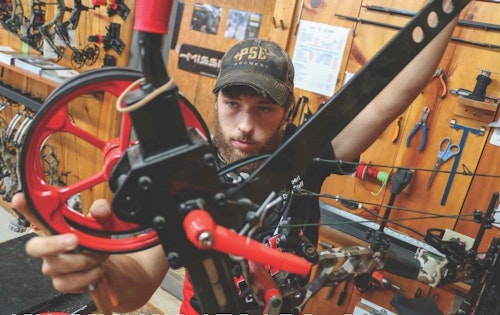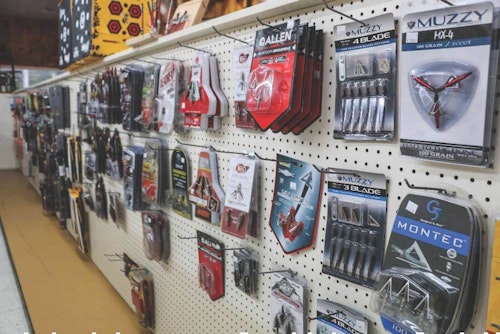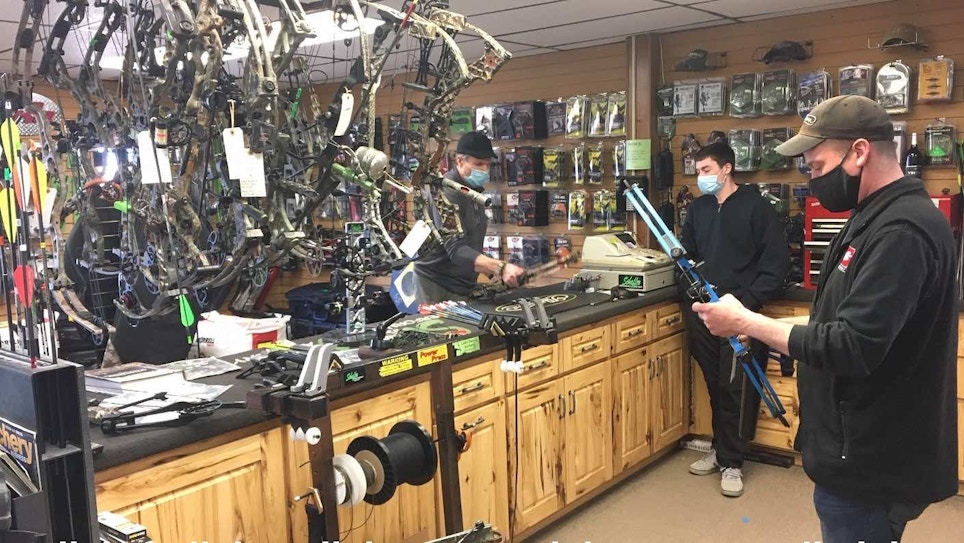It hit America like a Mac truck on a Monday morning. Companies temporarily closed down. Big and small businesses alike went bankrupt. Some shut their doors for good. While we aren’t here to argue the severity of COVID-19, understanding its effect on the archery industry is critical. Most reflect on 2020 and assume it wasn’t a good year for business. Was it?
Inceptive Panic
This isn’t the first pandemic, but it is the first major virus-related challenge most modern businesses have faced. By December of 2019, companies with manufacturing facilities began sweating as news of a deadly virus crept out of China. It wasn’t a top story on the evening news, but brands with channels of communication knew the truth, and feared the worst. Of course, concern for their fellow man topped the list, but business-related worries were unavoidably bothersome.
Then, by March 2020, the reality of COVID-19 took center stage. The economy grumbled, groaned and grated to a halt. Life stopped. Our world changed. And industries scrambled to soften the blow. Some achieved just that. Others accomplished much more, according to Xpedition Enterprises Executive Vice President Chris Cobbett.
“Where it is now and where it was when COVID started are different,” Cobbett said. “In March, we went into panic mode like everyone else. What are we going to do? How is it going to affect our business?”
The answer to those questions were different for each sector of the industry, and for every company within each sector. Business models, reactions, and shifts played roles in how well brands did during the stressful time.
Of course, some factors were uncontrollable, and certain challenges proved insurmountable. In short, most businesses that relied heavily on travel, public events and large gatherings reported major drop-offs in revenue. Archery competitions were shut down for months, and some within the target arrow market realized steep declines in sales due to decreased demand. Outfitters weren’t booking nearly as many hunts, leading to questionable times for hundreds of business owners. Trade and consumer show hosts canceled in droves, resulting in troublesome times for them, too. And conservation organizations that lived and died by the local banquet experienced the same. But bow sales? Yeah, that was an entirely different animal.

Adversity Required Adaptation
While virtually all companies had unexpected hurdles, not all of them tripped. “The guys who run our company were all wrestlers,” Cobbett said. “The wrestling mentality is, if you take a shot at one leg and the guy pulls it back, go for the other leg. Whatever goes away opens up another option. That mentality was our approach to COVID. Instead of sticking our head in the sand and pretending the world hadn’t changed, we rolled with it.”
Of course, archery shops closed down left and right. To combat this, Xpedition Archery made two major changes. First, rules were implemented to foster online sales. Secondly, they made available dropship on behalf of dealers. That way, despite doors being shut, dealers still had the opportunity to generate revenue and customers still received product.
“They were able to sell bows online using channels of influence and advertising,” Cobbett said. “We would ship a bow on their behalf. Payment terms were the same for us, but it still generated instant revenue for dealers.
“We’d also never worked with any type of mass merchant. We reached out to Sportsman’s Warehouse. Because of the way those guys run, they have a pro shop mentality with highly trained techs. Their stores were still open, and consumers could still access our brand.”
As a result, Cobbett says Xpedition Archery experienced a growth rate similar to that as prior to COVID. They didn’t lose bow sales on the vertical side, but it was hard to gauge crossbows because it was their first year selling them. Still, he says they sold a lot more than expected.
Getting product into the hands of dealers and customers was only half the battle, though. Planning for 2021 was the other. Mid-year is when most companies begin preparing for sales meetings with major retailers and independent dealers. The issue? Face-to-face discussions weren’t an option for most.
“A salesman who has been all over the country is not someone people are excited about having in their shop, and for good reason,” Cobbett said. “So, they want a virtual meeting with our salesforce. We put a lot of time and effort into designing how we’d meet that challenge.”
They conceptualized an effective program to replace in-person discussions. This increased efficiency, decreased expenses, and improved the bottom line.

High Demand
Bows weren’t the only products flying off shelves in 2020. Hunting clothing was, too. “The thing I was surprised by most was the demand for our Element Clothing,” Cobbett said. “People wanted clothing a good month earlier than the normal sales cycle. We normally see a big increase in August, but we were getting requests for early shipments back in June.”
Bear Archery is another company that pivoted and noticed surprising gains during the tumultuous time. “Last turkey season, there were way more people out hunting and more vehicles parked at public hunting areas than I’d seen in years,” said Bear Archery Product Manager Chris Parrish. “It was all about time. As negative as this thing can be, it could be one of the most positive things for the outcome of this industry that we’ve seen in a long time. You have to look at the good along with the bad.”
The good? Though it’s been a very negative period overall, it seems to have been pretty positive for bow manufacturers. Many businesses have grown, and sales are up, according to Parrish.
“Vertical bow sales have gone out the roof,” he said. “I think it’s strictly due to the fact that people aren’t doing the things that took up their summer months. How long that will last? Only time will tell. It might until February or March. It could go away sooner. I think there will be some trickle effect there.”
Either way, his hope is that the industry retains long-standing customers, as well as these new archers who joined ranks in 2020.
Low Supply
While manufacturers churned out product, supply chain was (and still is) the biggest challenge resulting from the coronavirus. Companies did everything possible to keep the gears turning. Demand was up, but supply was down. Meanwhile, smaller archery dealers, pro shops and retailers took the biggest hits. Consumers wanted product, but it was in short supply for most of 2020.
Interestingly, many vertical bows are made in America, so those orders were easier to fill. However, most crossbows are built overseas, which proved a bigger obstacle to overcome. Regardless, shutdowns limited most aspects of production.
“Supply chain has been the biggest negative impact,” Parrish said. “With factories shut down, even though it only lasted six, eight or 10 weeks overall, in manufacturing, that’s like three or four months when trying to catch back up. That’s just on backorder stuff.”
Sam Coffey, founder of Custom Wildlife Mounts and Outfitting, runs a taxidermy business and archery pro shop in Kentucky. He says his company was negatively affected by a state-mandated, non-essential shutdown that spanned months. That resulted in product order cancellations for many retailers.
“People started to panic and cancel orders because we weren’t sure when we’d be able to open back up,” Coffey said. “The biggest problem with doing that is canceling and reordering puts you at the back of the line. I had a big crossbow order in. I made that order, and when it got close to August, we cut that order in half. When we got to mid-August, we cut it in half again. We made big orders to manufacturers, and they couldn’t produce those. If we can’t get the product, we can’t sell it.”
As most might assume, sales generally decline once deer season opens. People want that new bow before opening day, not afterward. Still, countless retailers had to cancel orders to ensure they wouldn’t have to sit on expensive inventory for an entire year. It wasn’t a matter of hedging a bet, but more out of necessity.
Bow manufacturers weren’t numb to this problem; they understood the concern. Still, due to the same challenges Coffey referenced, they encouraged retailers to analyze their circumstances and make decisions accordingly.
“I think we’ll have a trickle effect well into 2021,” Parrish said. “Keep thinking about demand. Keep product in stock. And realize it isn’t that we don’t want to supply. We are in short supply. Every one of us are in the same boat.”
Parrish also stressed the importance of continued relationships between reps and shop owners. Reps are there to help dealers and retailers. Parrish says to keep them informed about concerns, goals and expectations. “They have their thumb on the needle when it comes to the manufacturing process,” Parrish said. “They know when things are going to be available. Because they work with so many dealers, they also know the trends and what products are most popular.”

Rising Hope
All things considered, bow sales surpassed expectations in 2020. Even third-party market analyzers hinted at a strong year. According to Business Wire (www.businesswire.com), COVID altered various industries in America, and impacts varied. Some industries registered drops in 2020, while others went unscathed, or even grew.
The numbers are promising, too. According to Business Wire: “Technavio has been monitoring the archery equipment market and it is poised to grow by $564.31 million from 2020-2024, progressing at a CAGR of over 8% during the forecast period.”
“Support from institutional bodies and the rising popularity of archery are the major factors driving the market,” it continued. “However, the presence of counterfeit products restraints market growth. The market is concentrated, and the degree of concentration will accelerate during the forecast period. To make the most of the opportunities, market vendors should focus more on the growth prospects in the fast-growing segments, while maintaining their positions in the slow-growing segments.”
Market Watch (www.marketwatch.com) is another popular source, and they too predict growth. According to its report, the global archery market should continue improving well into 2025. “In 2020, the market was growing at a steady rate, and with the rising adoption of strategies by key players, the market is expected to rise over the projected horizon,” it concluded.
Overall, the interest in archery is still there. People want to shoot their bow. They want to buy new stuff. And they are, even during a pandemic. “I think we’re going to keep seeing growth,” Parrish said. “And as an industry, we need to be prepared for it.”






